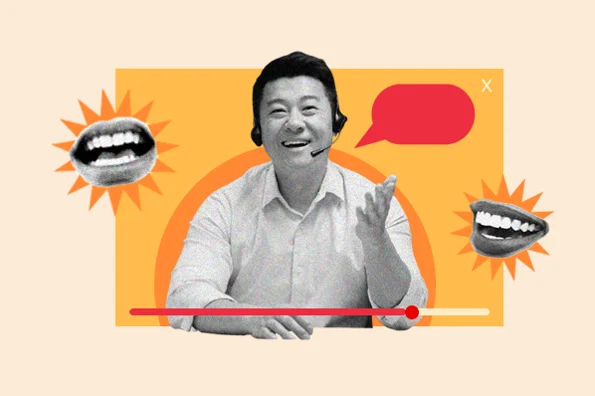Table of Contents
What is customer service training?
Customer service training is the coaching that employees receive to improve support and satisfaction among customers. A strong customer service training program includes exercises for improving interpersonal communication, product knowledge, conflict resolution, crisis management, and more.
There many types of customer service training. However, this training is typically an iterative process that involves teaching skills, competencies, and tools needed to better serve customers.
I think any employee interacting and dealing with customers is a good fit for customer service training, regardless of their seniority or experience level.
I’ve actually worked at some organizations that require everyone — from marketing to sales and leadership — to undergo customer service training and even get involved in some shifts. Since your customers are your best growth opportunity, every employee should work hard to keep them delighted.
Nowadays, customer-facing teams are labeled in many different ways: customer support, customer success, or customer service. For this article, I’ll refer to customer service when discussing service and support training.
Why is customer service training non-negotiable?
What experiences stood out to you more as a shopper: marketing tactics or customer service? Most likely, the latter.
Customer service is a company's opportunity to connect with customers, solve problems, and show they care.
And when customer service is executed well, it can resonate with customers for years. After all, people are more likely to return after a positive customer service experience.
That's why customer service training isn’t an optional add-on if you’re looking to stand out. It’s a core business investment with a demonstrably high ROI.
Here are a few of the reasons you should invest in customer service training programs.
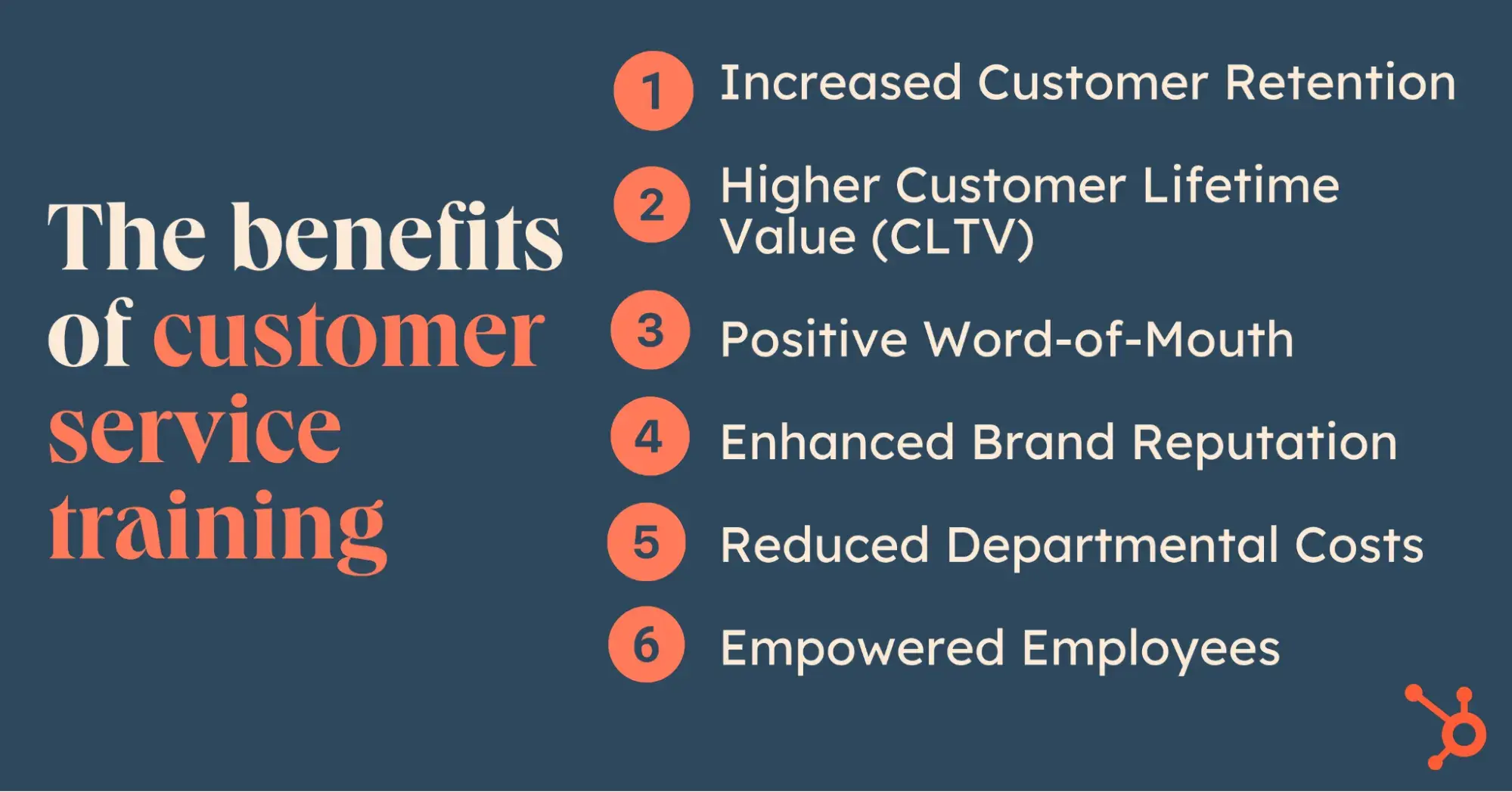
1. Increased Customer Retention
It's not uncommon for businesses to view their customer service teams as an afterthought. Once a consumer becomes a customer and pays for your product or service, the hard work is done, right? Wrong.
Happy, delighted customers come from excellent service and are your best advocates — even better than your most talented marketers.
Bain & Company’s research shows that even a modest 5% increase in customer retention can lead to a staggering 25% to 95% boost in profits. Why such a wide range? The profitability impact depends on factors like industry type, customer purchase frequency, and competitive landscape. However, the core principle remains the same: happy customers stick around, and they’re far less price-sensitive than new customers who are still assessing your value.
Real-World Example: Think about subscription-based businesses like SaaS platforms or streaming services. Their entire business model hinges on keeping customers engaged month after month. A single frustrating customer service interaction can drive churn, negating months or even years of revenue potential.
2. Higher Customer Lifetime Value (CLTV)
Loyal customers don’t just stick around — they spend more over time. The more positive experiences they have, the more likely they are to try new products, opt for premium services, and recommend the brand to others.
CLTV is the ultimate metric that reflects how well a business nurtures long-term relationships.
My Personal Insight: I’ve seen how companies with strong customer support training create lifelong customers. When I worked with a media brand in the ecommerce space, we ran a customer re-engagement campaign focused on proactive support.
Our support reps were trained not just to solve problems but to suggest complementary products and offer personalized discounts. The result? A noticeable increase in repeat purchases over a measured six months. This was especially effective when taking holidays and seasonality into account.
3. Positive Word-of-Mouth
In today’s hyper-connected digital landscape, consumer experience can become a public currency instantly.
A Nielsen study found that 88% of consumers prefer trusted, peer recommendations over branded content. The impact of these experiences is amplified through social media platforms, review sites, and online forums.
A single viral post about a negative experience can cause significant brand damage overnight, potentially leading to lost sales and a tarnished reputation. Conversely, a glowing review or a heartwarming customer service story can spark an influx of new customers and generate positive brand sentiment.
Real-World Example: Consider how Chewy, the online pet supply retailer, has built a reputation for exceptional customer service. In one notable instance, a customer contacted Chewy to return an unopened bag of dog food after their beloved pet had passed away.
Instead of processing a return, the Chewy representative told the customer to donate the food to a local shelter. They sent the grieving pet owner a heartfelt condolence card and a hand-painted portrait of their dog. This act of kindness went viral on social media, generating millions of positive impressions and cementing Chewy’s reputation as a company that truly cares about its customers and their pets.
4. Enhanced Brand Reputation
A good brand reputation does not happen quickly; it is the result of regular, pleasant consumer experiences across all touchpoints. It is about exceeding expectations rather than simply matching them.
Customers are more discriminating than ever, and they value honesty and openness. A business that consistently provides outstanding service, establishes genuine connections, and operates with integrity develops trust. This trust leads to customer loyalty, positive word-of-mouth referrals (as previously discussed), and perseverance in the face of adversity.
In a world where online evaluations and social media comments can make or break your brand, a solid reputation is a crucial asset.
Real-World Example: Apple has built a loyal fanbase by regularly producing high-quality products that provide a smooth user experience. Aside from the goods themselves, Apple spends extensively in customer assistance via the Genius Bar, online tools, and well-trained employees.
This commitment to customer satisfaction is shown in their remarkable ACSI score of 85 out of 100, which demonstrates the strong bond they have developed with their customer-base.
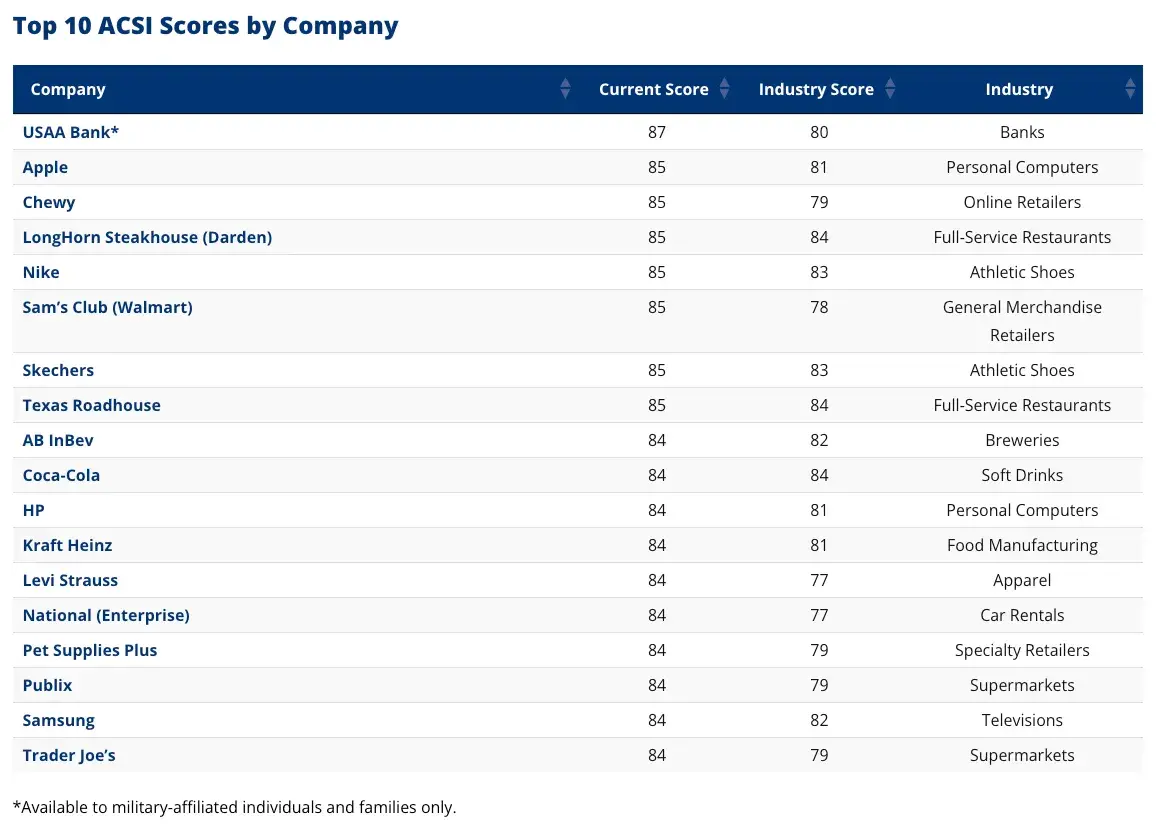
5. Reduced Departmental Costs
Investing in excellent customer service training can dramatically cut departmental costs.
Well-trained agents who can address issues effectively result in:
- Quicker handling times.
- Better first-call resolution.
- Reduced churn rates.
Each one of these helps to reduce overall costs.
AI Agents
AI-powered agent assistants improve efficiency even more. These systems give agents real-time access to knowledge libraries and decision-making tools, allowing them to confidently address complicated inquiries, frequently on their first contact.
AI can help improve call volume forecasts, resulting in more effective staffing decisions and lower overtime costs.
According to Nielsen research, AI-driven forecasting improved prediction accuracy by 7% while reducing personnel and overtime by 5%. Reinforcing strong customer service training with your AI-powered agents can go a lot further than time-based efficiencies.
Strategic Outsourcing
Finally, strategic outsourcing with a well-trained BPO partner can contribute to cost reduction by providing access to skilled resources and advanced tech. In fact, 55% of companies currently outsource some customer care operations, and 47% plan to increase outsourcing, highlighting the potential for cost savings and improved customer experiences through strategic partnerships.
My Personal Insight: I’m currently amongst the 55% of companies using these BPO partnerships and am finding it quite cost-effective.
6. Empowered Employees
In my experience, the difference between undertrained and well-trained customer service teams is night and day.
Undertrained teams often struggle with frustrated customers, leading to high turnover and low morale.
Conversely, companies that invest in comprehensive training cultivate confident teams who take pride in their work. This positive attitude translates directly into better customer interactions, increased customer satisfaction, and improved business results.
My Personal Insight: At Greenhouse Software, I managed a distributed support team across San Francisco and New York City. To foster a collaborative environment despite the distance, standardized support operations were non-negotiable.
I created comprehensive playbooks, career ladders, and workflows, providing agents with clear expectations and opportunities for growth. The impact was clear: improved team efficiency, consistency, and key support metrics, including NPS and CSAT.
Hiring vs. Training Customer Service Candidates
Throughout my career in hiring manager roles, I’ve seen how recruiting people with good customer service abilities is critical, but it’s never enough by itself. Even the most naturally empathetic, eloquent, and problem-solving individuals require systematic training to achieve true success.
Why? Because customer service is about more than simply individual ability; it’s also about alignment. Even outstanding hires will not comprehend your company’s values, processes, and customer service requirements unless they are properly trained.
In my experience, companies who hire primarily for soft skills and ignore training provide uneven service experiences. One representative may go above and beyond, while another –– equally skilled –– may be less proactive simply because they were not given explicit directions. This contradiction can reduce customer trust.
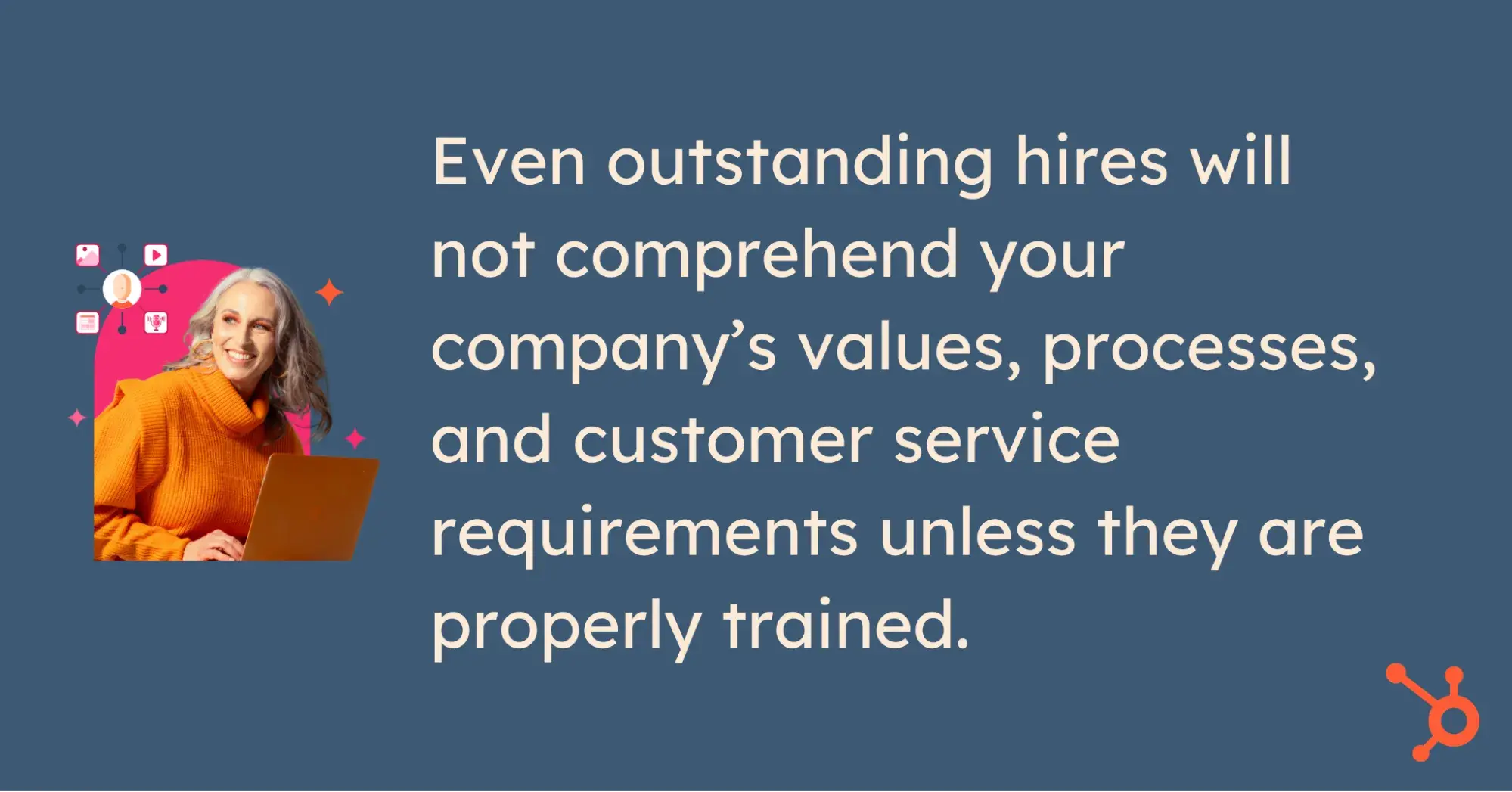
Skills to Look for When Hiring for Customer Service
The right people make all the difference. While I prioritize training, I am also aware that the recruiting process is the cornerstone for excellent service. When I’ve developed or worked on customer support teams, I’ve looked for applicants who have a combination of emotional intelligence, flexibility, and problem-solving abilities. These are not only desirable attributes, but they have a real influence on customer happiness.
There’s research to back this up. McKinsey discovered that organizations with highly competent frontline employees experience up to a 30% improvement in CSAT and a 20% rise in revenue.
This shows that employing the right people is more important than just providing good service; it’s also about improving organizational success.
Over the years, I’ve learned that the best customer service professionals share a specific set of traits that go beyond just being friendly. Here are five traits I prioritize when building a strong, customer-focused team.
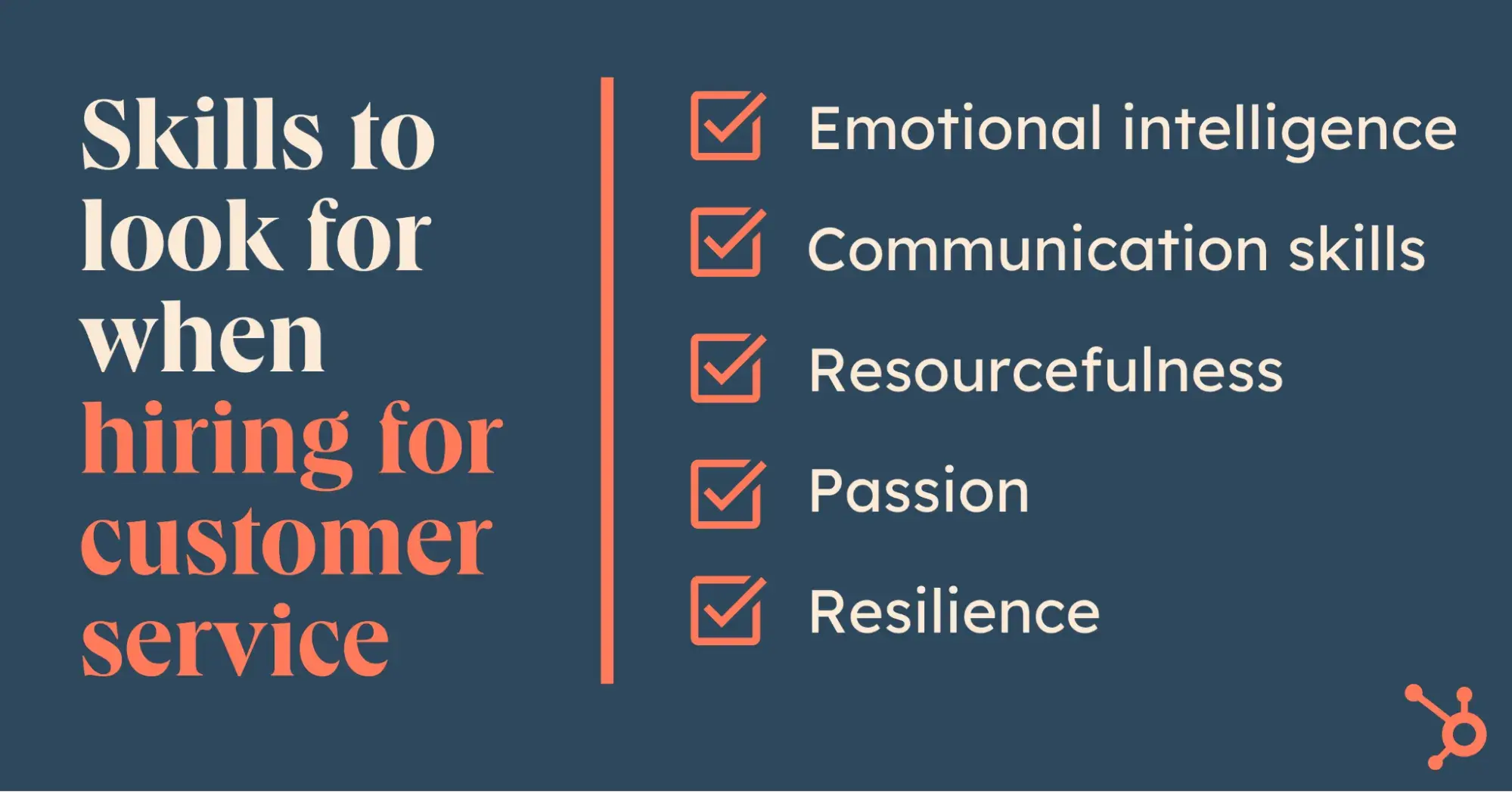
1. Emotional Intelligence
I’ve discovered that the finest customer service representatives can read between the lines. They understand how customers feel and not just what to say. A high EQ enables agents to defuse difficult situations and foster pleasant interactions.
2. Communication Skills
Clear, professional, and compassionate communication is essential in customer service. Whether written or spoken, the ability to present difficult facts in a clear, comforting manner makes all the difference.
3. Resourcefulness
I often question candidates about how they’ve dealt with difficult customer situations in the past. An excellent service rep does more than just read scripts. They think critically to develop solutions that benefit both the customer and the organization.
4. Passion
While passion isn‘t quite a skill, it’s fundamental to going above and beyond in customer service.
Delighting your customers and turning them into superfans of your company means that your support team should have a sense of excitement and passion for the success of both the company and the customer.
Your candidates might not have a strong passion for your company just yet. However, they should be passionate about working with people — specifically, your customers — and helping others solve their problems.
5. Resilience
Dealing with complaints, angry customers, and high-pressure circumstances is part of the job. I admire folks who can keep their poise and professionalism even when things don’t go as planned.
It’s important to hire for and continue to build resilience and keep team member morale high.
Customer service training ensures that your team can adapt to all kinds of different situations.
After all, when your team understands the key principles that guide your customer service philosophy, they're better able to apply that knowledge to every customer they encounter.
While the concept of customer service training is to train your team to serve and delight, specific training methods and practices vary based on your company, your employees, and a variety of other factors.
Below, I’ll break down a few instances where you might conduct customer service training and what you can expect as a hiring manager or owner.
1. New Hire Customer Service Training
As with any new role, the first month or two of training can dictate an employee‘s long-term success with your company. Customer service training for new hires isn’t any different and should be an essential part of onboarding.
This specific type of training will help new employees acclimate to a new job, company, and culture and ensure they're ready to communicate with your valuable customers.
New hire CS training should include:
- Welcome and orientation
- Product knowledge training
- Customer service skills training
- Systems and tools training
- Performance expectations
2. Ongoing Customer Service Training
Whether your customer service team has been around for six months or six years, they should still undergo regular, ongoing training. Consider revisiting this every quarter, half-year, or year, depending on what works best for your company.
What this training looks like also depends on your company. Here are some of my recommendations:
- Refresher courses
- New product or feature training
- Advanced skills training
- Industry trends and best practices
3. Emergency or Time-Sensitive Customer Service Training
Sometimes, customer service training can‘t be planned. Perhaps there’s a product recall, a major rebranding, or a national advertising campaign.
This type of customer service training can also result from news breaking in your industry that may have your audience taking notice, even if it doesn't directly involve your company.
Considering 90% of customers rate an “immediate” response as important, you must prepare your front-line employees (your customer service team) to take calls, answer questions, and resolve conflicts at the ready.
Emergency customer service training is all about equipping your team with everything they need to know to do their job and help your audience. Regardless of the situation, it’s important to include:
- Crisis communication training
- Product or policy changes
4. Customer Service Phone Training
Despite the rise of digital channels, 48% of customers still prefer to resolve customer service complaints over the phone. When they do, they expect fast, clear, and empathetic support. A single poor phone experience –– long wait times, unhelpful agents, or robotic scripts –– can drive customers straight to your competitors.
Customer service phone training ensures that your agents know how to actively listen, de-escalate frustration, and provide effective solutions in real time –– something chatbots and emails can’t always accomplish.
One of the best ways to sharpen phone skills is through role-playing exercises. Set up scenarios where your team members practice how to:
- Quickly identify the root of the problem.
- Match the customer’s tone and show empathy.
- Communicate clearly and confidently.
- Offer resolutions without excessive hold times or transfers.
5. Live Chat Customer Service Training
Live chat isn’t just popular –– it drives sales. 38% of consumers are more likely to buy from a company that offers live chat support. Having live chat is great, but how well your team is trained makes all the difference. Without the right skills, reps can come across as slow, robotic, or unhelpful, turning a valuable tool into a frustrating experience.
Live chat may seem like just another support channel, similar to phone support, but it requires a different approach.
- Speed and efficiency. Customers expect quick responses, so reps must handle multiple chats without losing quality.
- Tone and personalization. No voice cues mean tone must come through in word choice, punctuation, and even emojis (when appropriate).
- Clarity and brevity. Chat responses should be short, to the point, and easy to understand.
- Empathy through text. Without voice inflection, reps must read between the lines and respond with care.
Here are some live chat trainings that work:
- Role-playing and chat simulations
- Pre-written scripts and guidelines
- Speed and multitasking training
- De-escalation tactics
The bottom line? A well-trained live chat team can help increase conversions, boost customer satisfaction, and build loyalty. If you’re not investing in training, you’re leaving revenue on the table.
Now that I’ve covered the importance of hiring and specialized training, I’m going to break down the essential skills every customer service rep needs to succeed.
Customer Service Training Basics
Ensuring your reps learn the following customer service basics and soft skills will make all the difference in your company‘s growth. Your employees face customers every day. Customers will judge your business based on interactions with your people and your reps’ behavior.
Let's dive into each of the customer service basics and soft skills your reps need to succeed in their roles.
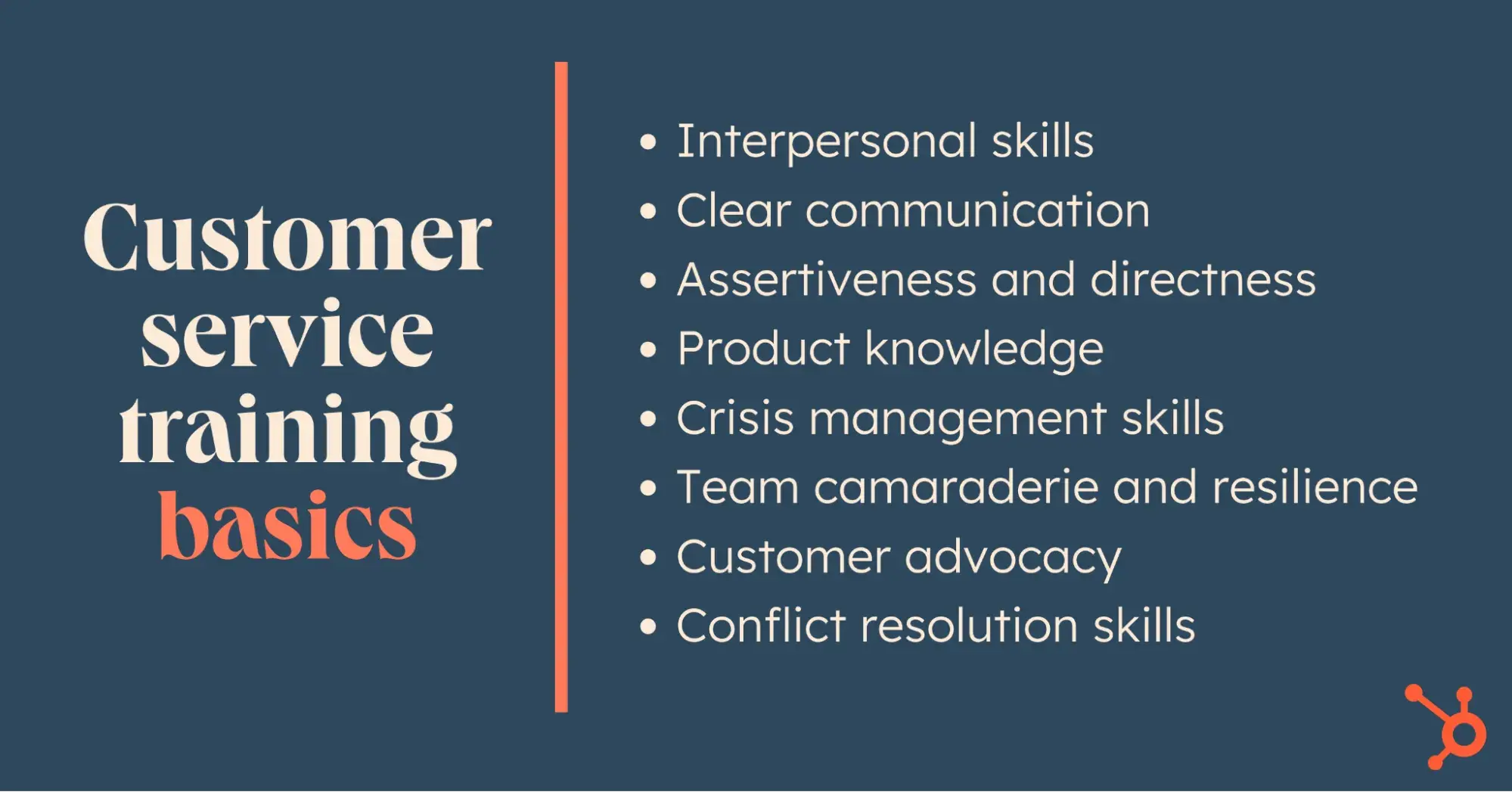
1. Interpersonal Skills
Great customer service starts with strong interpersonal skills. Reps need to build trust, create positive interactions, and make customers feel heard.
- Positivity: A simple shift in language makes a huge difference. Instead of “I’m afraid we can’t do that,” train reps to say, “I’d love to help; let’s find a solution.”
- Empathy: Customers want to feel understood. In my experience, being genuine goes a long way. Encourage reps to recall their own frustrating customer experiences to build genuine empathy.
Training Exercises:
- Rewrite negative customer service responses into positive ones.
- Role-play difficult conversations, focusing on using empathetic language.
- Review anonymized chat transcripts to spot and improve tone.
2. Clear Communication
Reps need to explain solutions quickly and clearly. Confusing explanations can lead to frustrated customers and longer resolution times.
- Keep it simple. Customers don’t need technical jargon. Use clear, straightforward language.
- Be concise. Long-winded responses waste time. Aim for clarity in as few words as possible.
Training Exercise:
- Challenge reps to explain a product feature in five minutes or less, like they would to a first-time customer. You can do this during standup meetings, similar to a pop quiz.
3. Assertiveness and Directness
Customers expect confident, knowledgeable support. Wishy-washy responses create doubt.
- Be direct. Get to the point and provide actionable solutions.
- Establish authority. Customers should feel like they’re in good hands.
Training Exercise:
- Role-play a scenario where a rep must calmly take control of a tense customer conversation and guide them to a resolution.
4. Product Knowledge
Reps need a deep understanding of your product to troubleshoot efficiently and educate customers. Customers lose confidence in a company when a support rep struggles to answer basic questions or gives incorrect information.
Training Exercises:
- Mentorship program. Pair new reps with experienced employees from different departments to give them a well-rounded view of the company.
- Job shadowing. Have reps observe different teams, from product development to marketing, to better understand how the product works and how it’s positioned.
- Knowledge base challenge. Have reps contribute to the knowledge base through FAQs, guides, or troubleshooting tips –– reinforcing their understanding while creating valuable resources for the team.
Learn how to set up your knowledge base of articles in HubSpot's Service Hub.
5. Crisis Management Skills
According to research, 83% of customers feel more loyal to brands that effectively respond to and resolve their complaints. Training representatives to manage high-pressure situations can transform complaints into loyalty. These are personally some of my favorite customer interactions. Difficult at first, but very rewarding in the end.
Pro tip: Use our management plan templates to plan your crisis communication.
A well-handled crisis not only resolves the issue but also strengthens customer trust.
- Stay calm under pressure. Reps should be trained to de-escalate tense situations rather than reacting emotionally.
- Focus on solutions. Customers don’t want excuses; they want to know what’s being done to fix the issue. Proactive problem-solving is key.
Training Exercises:
- Conduct mock calls where reps practice handling angry customers, focusing on keeping the conversation productive.
- Teach the LAST method (Listen, Acknowledge, Solve, Thank) as a structured approach to navigating difficult interactions.
6. Team Camaraderie and Resilience
Customer service can be mentally draining and burnout is real. A strong, supportive team culture improves performance, morale, and retention. When reps feel supported by their team, they handle difficult customer interactions more effectively.
Yes, it can be you’re occasional pizza party, but I’ve personally liked sending updates to the entire organization as to what’s going on in customer service. I’ve found that a collaborative and transparent, cross-departmental work environment can really enhance this level of camaraderie and support.
Training Exercises:
- Encourage meditation apps like Headspace to help with stress management. Even five-minute mindfulness exercises can reset a tough day.
- Organize team outings or virtual team-building games to strengthen relationships and create a positive work environment. Just make sure they’re fun and engaging, otherwise they’ll feel forced.
- Use leaderboards or friendly competition to boost motivation and celebrate top performers in a way that encourages growth rather than unwanted pressure. I typically take a pulse from my team on this.
7. Customer Advocacy
Satisfied customers can become brand advocates if reps go the extra mile. Customer service, while surely about fixing problems, is also about building long-term relationships that turn customers into promoters of your brand.
- Use positive, team-oriented language. Instead of “I can’t do that,” say “Let’s see what we can do together.” Small phrasing shifts create a more collaborative experience.
- Encourage feedback. Collect customer feedback regularly and use it to improve service and refine customer service training. Customers feel valued when they see their feedback in action.
Training Exercises:
- Create a “Say This, Not That” guide to refine how reps communicate, ensuring they align with the company’s customer-first approach.
- Set up gamified challenges to reward reps who go above and beyond to turn satisfied customers into brand advocates.
8. Conflict Resolution Skills
Handling customer complaints is part of the job, and reps need to stay calm under pressure. Conflict resolution skills prevent issues from escalating and ensure customers feel heard and respected.
- Acknowledge the frustration. Even if a rep can’t provide the solution the customer wants, validating their feelings can de-escalate tension.
- Stay professional. Heated conversations can be challenging, but it’s crucial for reps to remain calm and not take things personally.
Training Exercises:
- Teach your team to use active listening and “I” statements to shift conversations toward solutions rather than arguments.
- Have reps practice resolving conflicts without placing blame, focusing instead on finding a mutually beneficial resolution.
The best teams continuously refine their skills, adapt to changing customer expectations, and stay up-to-date on their latest products (or services).
Next, let’s look at some training tips to kickstart your revamped customer service training program.
Customer Service Training Tips
At it’s core, effective customer service training is about effective tactics that produce tangible results. I’ve worked with a number of teams to improve training processes, and I’ve seen how effective, continuing training can greatly impact service delivery.
Here are some practical, no-nonsense tips that I utilize when planning and conducting a customer service training program.
1. Evaluate Training Needs
Before you begin training, you must first assess your team’s current situation. You can’t build a one-size-fits-all program until you know what your team actually needs. I always advocate a multifaceted method to analyze training needs.
- Surveys. I’ve discovered that directly asking team members for input provides excellent insight into areas where they believe they require additional support.
- Interviews. Speaking one-on-one with your team can disclose unique pain concerns and skill shortages that surveys may overlook.
- Observations. Consider how your team interacts with customers. Are there any common issues? Are there any recurring frustrations that can be addressed through training?
Starting with a detailed needs assessment allows you to develop a tailored training roadmap that is both relevant and impactful.
2. Set Clear Objectives
Training without clear goals is similar to driving without a map. Okay, maybe not the best analogy. But similar to planning for a new destination, it’s important to define clear, quantifiable objectives from the beginning to ensure that everyone understands the desired outcome.
For example, do you train your team to improve:
- Response time?
- Problem-solving ability?
- Upselling or cross-selling skills?
- Empathy and emotional intelligence?
Each goal should be specific and measurable.
For example, a goal might be: “Reduce customer complaint escalation rates by 20% in the next six months.” This makes it clear what success looks like both for your team and the customers they service.
3. Choose the Right Training Methods
I’ve discovered that using a range of training modalities is critical to maintaining engagement and effectiveness. This is what I recommend:
- Online courses. They are flexible and appropriate for complicated and basic study. I’ve used Udemy and LinkedIn Learning, amongst a few others, to help teams learn new software or communication skills.
- In-person workshops. These are ideal for interactive learning, particularly when you want to stimulate teamwork or go deeply into difficult customer service situations.
- Role-playing exercises. Reps should practice real-world examples. Set up scenarios in which they can deal with difficult consumers, increasing their confidence in real-world situations.
- Simulations. I enjoy simulation-based training tools that stimulate actual customer interactions. It offers hands-on experience with low risk.
- On-the-job training. Allow your team to learn via experience, with mentors or senior representatives providing assistance and guidance where needed.
The goal is to develop a dynamic training environment that caters to various learning styles –– visual, auditory, and even kinesthetic –– while maintaining team engagement and investment.
4. Provide Ongoing Support
Customer service training cannot be a one-time affair. As I’ve mentioned throughout this guide, ongoing assistance is the secret sauce that keeps the team going. Here’s a simple recipe I use to keep training current and relevant:
- Regular check-ins. I recommend bi-weekly or monthly check-ins to review progress and allow reps to ask questions and clarify any challenges they’ve experienced in the field.
- Feedback loops. Training is a continuous process. I constantly request regular input from the team to identify areas where they require additional resources or direction.
- Resource libraries. Create a library of training assets, like articles, videos, FAQs, or even scripts, for team members to use as needed. This becomes a live resource that allows them to constantly expand their knowledge.
- Embedded Workflow Support: Use a digital adoption platform (DAP) to provide real-time, in-app guidance and process reinforcement for your support reps. With contextual walkthroughs, tooltips, and self-help widgets embedded directly into your support software, reps get on-the-job training in the flow of work—reducing ramp-up time and minimizing errors.
Training should feel like a continual journey rather than a final goal. Ongoing support ensures that customer service representatives are constantly developing and adjusting to their customers’ needs.
5. Measure and Evaluate
Here’s where the rubber hits the road. To ensure that your efforts are successful, you must track your progress. I use data and analytics to assess the efficacy of training programs. Here’s how.
- Customer satisfaction scores. Monitor how customers evaluate their interactions with your reps. If the training is effective, you should notice an improvement in these results.
- Employee performance metrics. Use ticket systems to monitor important performance indicators such as first-response time, resolution time, and number of resolved tickets. To assess improvement, compare the before and after training results.
- Team feedback. Remember to check in with your team. How comfortable are they with the abilities they’ve learned? Do they feel more prepared to handle customer interactions? This input might help identify training shortages or new areas for improvement.
I’ve found that scheduling regular evaluation intervals, such as quarterly evaluations, helps keep training goals on track. And if something’s not working? It’s an opportunity to adjust the approach to make it even more effective.
Free Customer Service Training Materials
A lot goes into customer service training, and it can be a daunting process to manage alone. Thankfully, there are plenty of customer service training materials available online.
I've gathered some of my favorites below.
1. Customer Service Training Manual [Download for Free ]
Aligning your team with universal training documentation is an assured way to inform new hires of their roles, goals, and expectations.
You can use this free customer support training manual template to build a customizable business manual.
In this template, you'll get:
- New hire guide. This part of the template allows you to welcome your new customer service reps and give them an overview of the team. Customer service reps are one of the roles with the highest turnover, so you want to get them started on the right foot.
- Training timeline. This short, flexible section allows you to give ballpark dates for when certain parts of the training will start and end.
- Tech and software setup. Your reps will need to leverage many tools to get their job done efficiently, but you don't want them to feel overwhelmed. Use this section to outline where they can get a monitor and headset, which customer service software and CRM they'll use, and how to access and set up each tool.
- People to meet. Remember that camaraderie I was talking about earlier? You should strive to foster that starting from the training period. Giving your reps a list of people to schedule “coffee chats” with can help them get acquainted with the team more quickly. This is especially important if your customer service team is remote.
- 100-day goals. A strong 100-day or 30-60-90-day plan can get your rep started on the right foot and give them guidelines for how they should perform by a certain date. Reassure your reps that they'll be “ramped up” to full performance standards by outlining what will be expected of them as time goes on.
- Feedback and reviews. Providing feedback as you train your customer service rep is essential for ensuring their success. This section lets you set dates for checking in with your new rep. These meetings don't have to be formal, but you should know how to conduct a performance appraisal before starting one.
- Interacting with customers. In this section of the manual template, you can provide a few guidelines for fostering a positive customer service tone during the call. You might also link to your customer service scripts and/or role-play scenarios.
- Escalation framework. A top-performing customer service rep knows when to escalate a problem to someone who can deal with it more effectively. This part of the manual gives your new reps guidance on when to do just that.
- Product FAQ. While you should hold a dedicated product training during your new hire onboarding process, you should still include an easy-to-reference section with FAQs about your product.
- Resources for success. Leave the customer service rep with a list of tools that will help them get acquainted with the ins and outs of their role. You can include logistical information here and also inspirational materials, such as a video from the CEO.
2. Customer Service Training Courses
Online customer service training courses teaching vital skills can be a great addition to your training program. As self-led seminars, employees take ownership of their training and are exposed to skills and competencies outside the organization.
Below is a short list of some free customer service training courses for your team.
Course Recommendation: Delivering Exceptional Customer Support by HubSpot
This short course from HubSpot will acquaint your reps with key competencies and tactics for delivering support your customers will praise you for.
It's a quick course — less than an hour long — making it an ideal and convenient addition to your training schedule. You could even get your entire customer service team in one room and play it for them at once.
The course is split into three sections:
- Understanding customer support competencies. Your reps will learn the basic skills they need to deliver excellent support and how to improve those skills continuously.
- Support case framework. Your reps will learn how to structure their approach to each case to resolve customer issues more effectively.
- Managing your time as a customer support rep. Time management is the lifeblood of a strong workflow. In this short lesson, reps will learn how to increase their productivity.
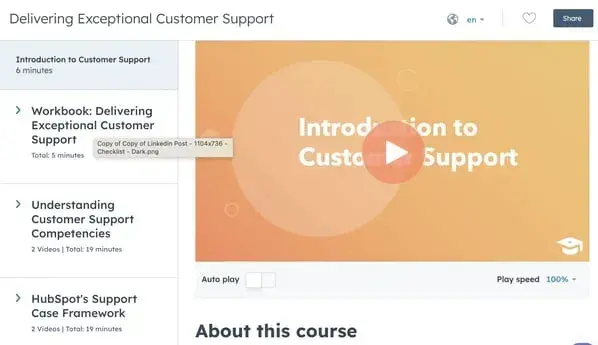
Course Recommendation: Customer Service Training by Alison
Alison is a digital education hub that offers free courses and paid certifications on various skills. Its customer service training course is geared towards beginners in the field, so it's a perfect place to start.
This course will give your employees an understanding of essential customer service factors and help them understand how to deliver a customer-friendly approach that's best for your business needs.
They‘ll also learn the benefits of providing excellent service and cover a few do’s and don'ts when dealing with customers.

Course Recommendation: Professional Certificates and Training by edX
Like Alison, edX is another fantastic online learning platform that can be a valuable asset for customer service training. It offers a wide variety of courses on topics such as communication, conflict resolution, and customer experience management –– all of which are essential skills for customer service representatives.
Many of the courses on edX are created by top universities and institutions around the world, ensuring high-quality content and instruction. The platform also offers the flexibility of self-paced learning, allowing your team to learn at their own speed and convenience.
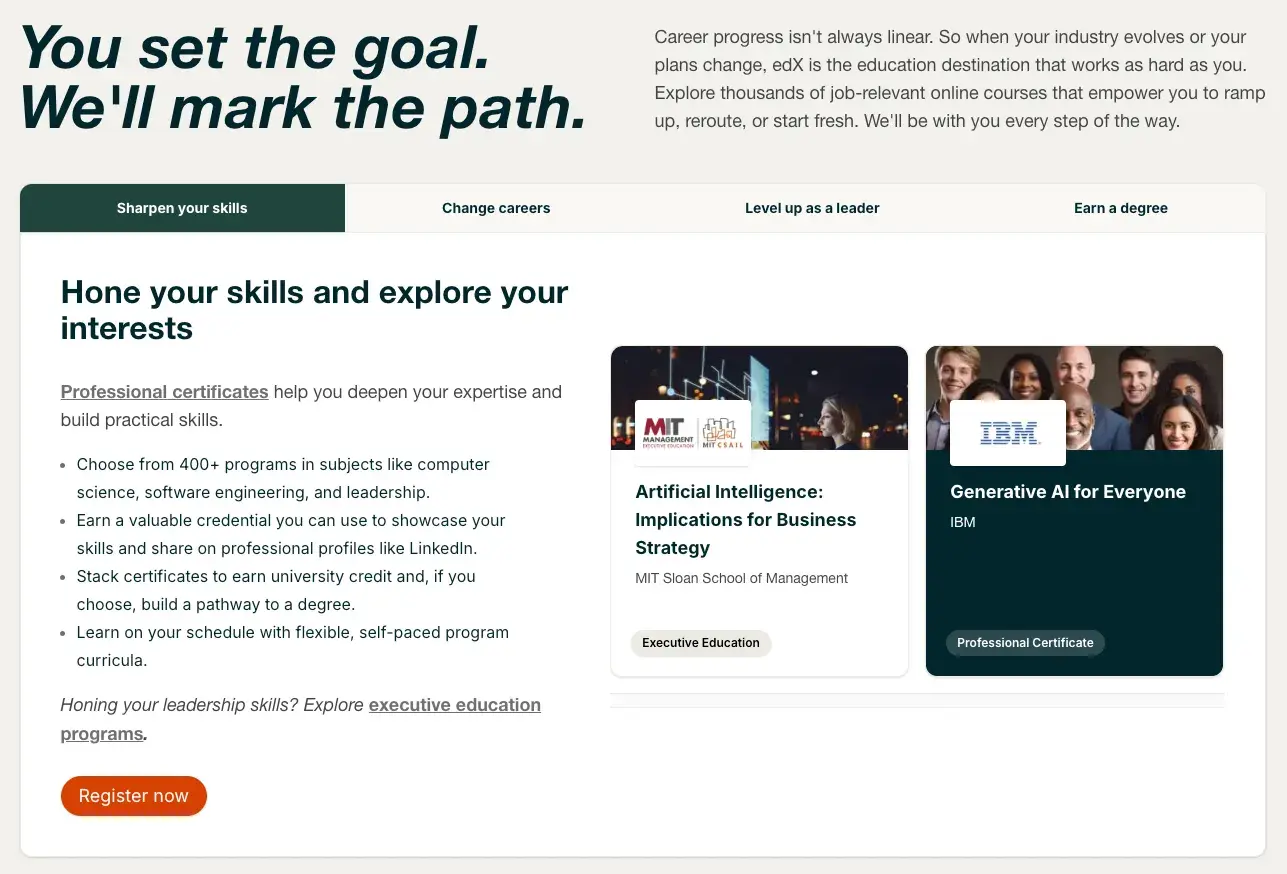
Course Recommendation: Customer Service Training by GoSkills
GoSkills, an innovative online learning platform, is dedicated to helping organizations and individuals worldwide acquire essential business skills.
Their customer service training, led by the dynamic David Brownlee, goes beyond generic courses. It offers engaging lessons such as “Psychology of Your Company,” “Verbal and Nonverbal Cues,” and “Anticipate Customer Needs,” among others.
Your team can access this invaluable course through a free trial or via your organization‘s GoSkills Courses or GoSkills Platinum plan. It’s also important to note that all GoSkills courses are CPD-accredited, ensuring the highest standard of professional development.
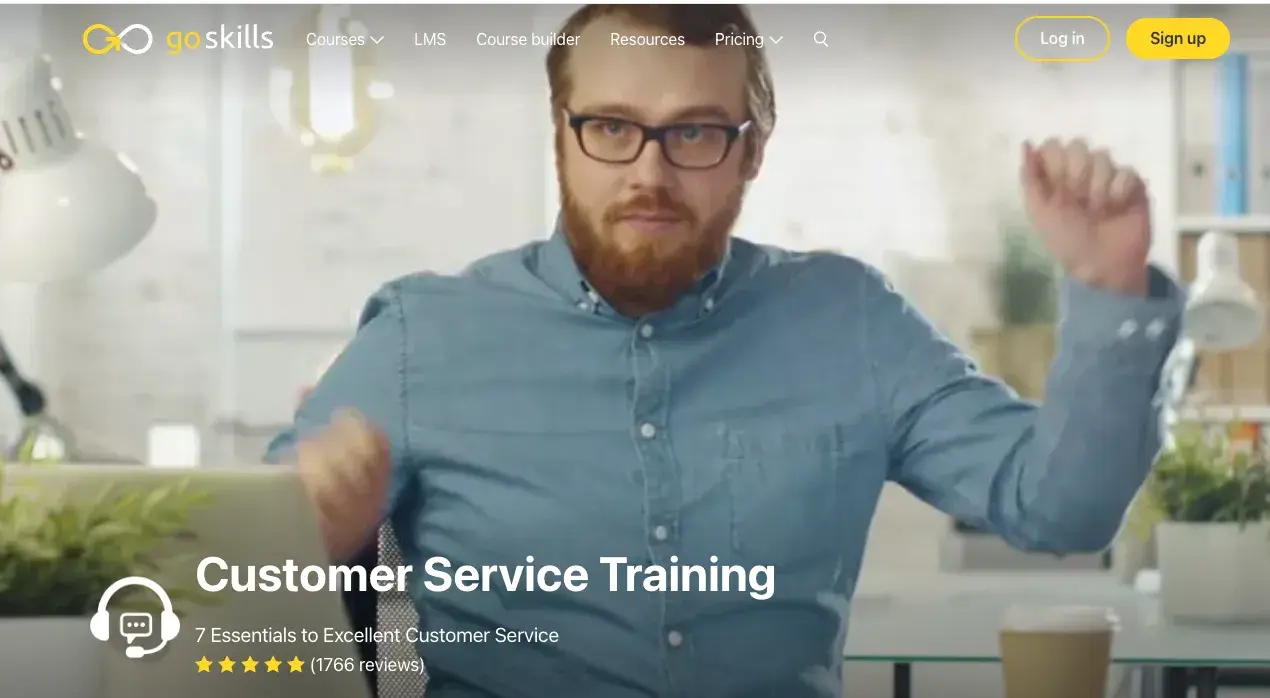
Course recommendation: Innovative Customer Service Techniques by LinkedIn Learning
LinkedIn Learning is an award-winning online education platform run by the most popular professional social media platform. It primarily teaches digital and business-related skills.
The Innovative Customer Service Techniques course is created and presented by customer service expert Jeff Toister and consists of a short 45-minute video.
Your employees can access the course through a seven-day free trial or join LinkedIn Learning's paid membership.
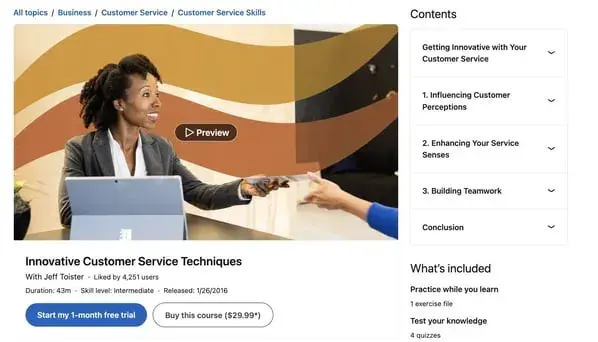
Course Recommendation: Business Courses by Treehouse
Treehouse is another online course library, but the program requires a paid membership. HubSpot uses Treehouse for our own customer support and service training. Treehouse offers courses on soft skills and others that may contribute to overall customer service education.
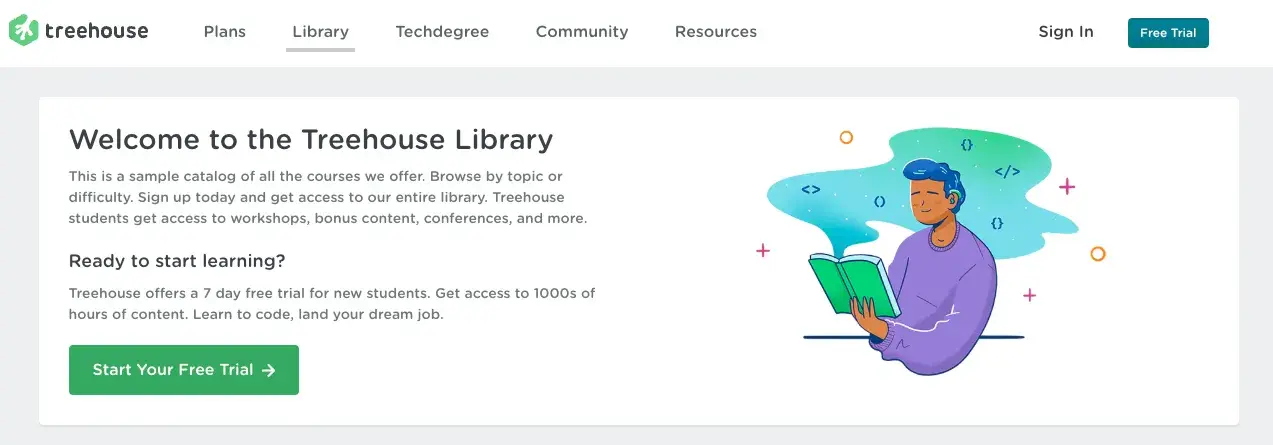
3. Customer Service Training Games
Using games and activities can make customer service training much more fun. Whether they require materials like a whiteboard or simply involve your team, games are a way to teach valuable skills while encouraging teamwork and collaboration between your employees.
Check out these free, quick-and-easy games to play during customer support and service training:
- Fun and Powerful Training Games for Customer Service Teams by UserLike
- Free Customer Service Training Games by BusinessTrainingWorks
4. Customer Service Training Videos
Sometimes, it‘s valuable to incorporate outside insight or perspective during customer service training. Best of all, it’s not something you have to do on your own.
Videos from thought leaders and industry experts are powerful additions to your customer service training programs.
Here's an example of a well-made, valuable customer service training video (also, check out this post for more videos). In this 12-minute video, business coach and consultant David Brownlee explains the essentials of customer service in friendly, easy-to-understand language. With over 4,000 likes, the value of this video speaks for itself.
Grow Better With Effective Customer Service Training
Consumers increasingly view customer service as a critical indicator of how much a company values them. With your customer service team on the front lines of service and retention, they need to be properly trained and equipped to handle any challenge that comes their way.
I’ve seen how implementing effective customer service training and support strategies can lead to higher customer satisfaction and loyalty, ultimately driving your business to new heights.
Editor's note: This post was originally published in June 2018 and has been updated for comprehensiveness.

.webp)
.png?)
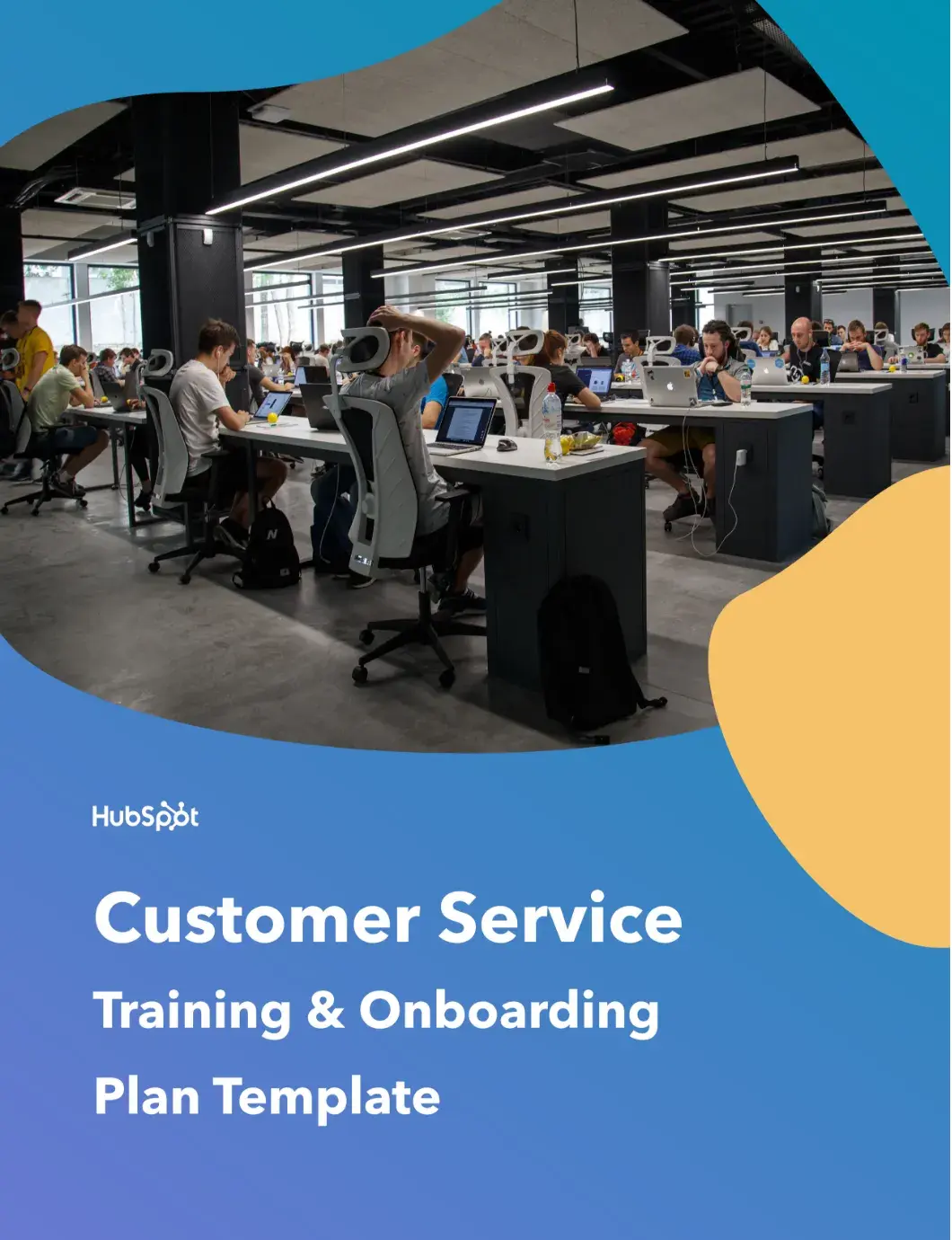
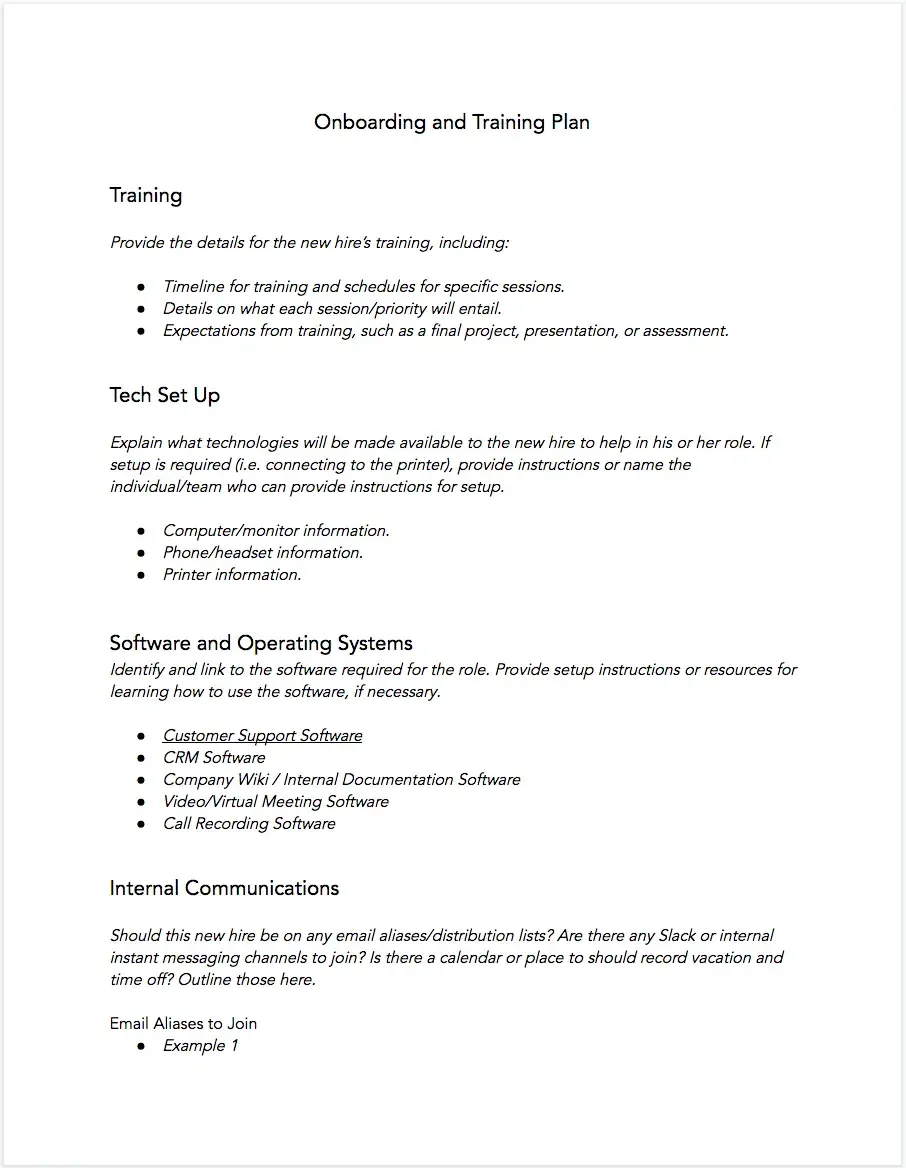

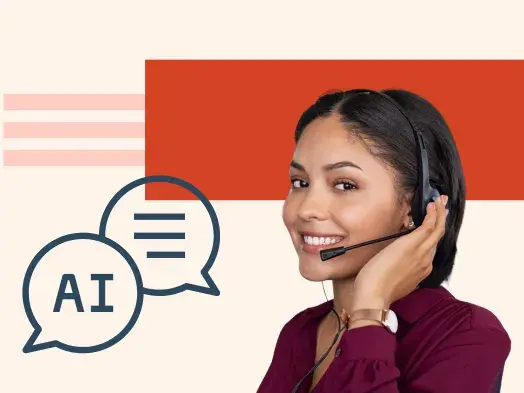
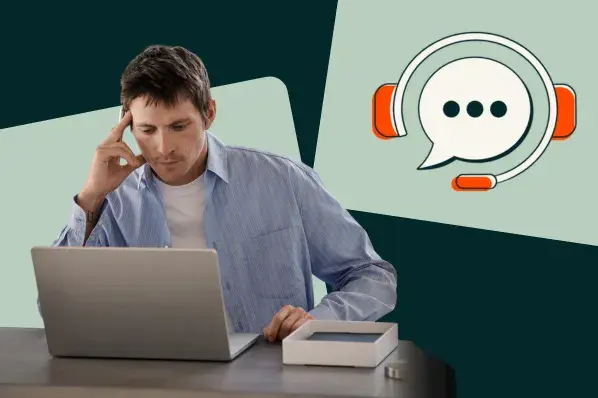
.png)
